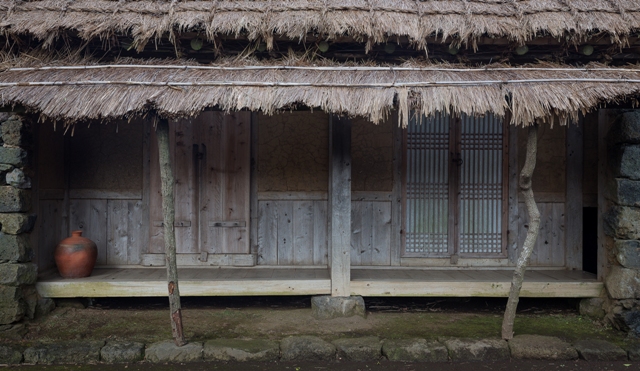| |
 |
|
| ▲ Photo courtesy The Jeju Weekly |
Some historians estimate that houses have been built with a straw thatched roof on Jeju since between 6,000 and 2,000 years ago.
These traditional homesteads are steeped in the history of the island and everything from their size and layout to the materials used have been shaped by Jeju’s environment and culture.
Each traditional household is actually made up of two separate buildings. These are the angeori (main building) and the bakgeori (subordinate building). While, in other regions in Korea, families are separated by gender, the angeori and bakgeori in Jeju allow for each generation to live separately.
For example, the parents will live in the angeori while their married children will live in the bakgeori. Parents and children also usually cook and dine separately and use a separate kitchen.
This separation of the extended family means that families were able to live a more independent life away from their parents. Some people have even gone as far as to say that what we see in traditional Jeju houses is a ‘nuclear family’.
As well as the family unit, Jeju’s natural environment played a big part in the development of these houses. For example, the walls are made from black volcanic stone that has been layered together in a similar way to Jeju’s batdam stone walls.
As with many things on Jeju, the strong winds also played a large part on the way the houses were designed. For example, when compared to the mainland, houses on Jeju are smaller, as it makes them less susceptible to wind damage.
In addition, the eaves of the house are narrower to stop the wind catching and literally blowing the roof of the houses off. These factors come together to give houses on Jeju a look that is quite different to traditional houses on the mainland.
When looking at these buildings there are three main places where it is possible to get a glimpse into this older way of life: Seongeup village, Pyoseon folk village and the folk village at Jeju Stone Park.
| |
 |
|
| ▲ Photo courtesy Douglas Macdonald |
Each of these villages has its own unique features that make it an interesting place to spend a few hours. Songeup folk village, for example, is a real village with people still living in it. Pyeoseon folk village, on the other hand, contains many traditional houses, but the focus is more on tourism and, as such, the village’s design isn’t accurate.
Like Pyeoseon Folk Village, the village at Jeju Stone Park is also a reconstruction, however, everything from the houses and the layout, to the village tree, has been carefully recreated according to how villages would have been originally designed.
In the midst of a construction boom on Jeju, spending a few hours at one of these sites is an excellent way to get an impression of how people on Jeju used to live.
|





















